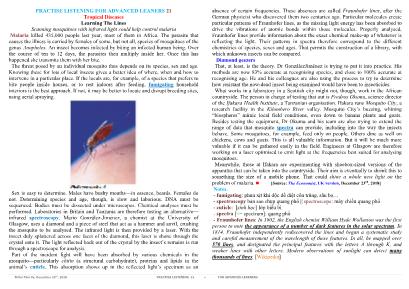Bài thực hành nghe Tiếng Anh nâng cao - Bài 21 - Thẩm Tâm Vy - Năm 2018 (Có âm thanh)
Bạn đang xem tài liệu "Bài thực hành nghe Tiếng Anh nâng cao - Bài 21 - Thẩm Tâm Vy - Năm 2018 (Có âm thanh)", để tải tài liệu gốc về máy bạn click vào nút DOWNLOAD ở trên

Thẩm Tâm Vy, December 23rd, 2018 PRACTISE LISTENING 21 ~ FOR ADVANCED LEARNERS PRACTISE LISTENING FOR ADVANCED LEANERS 21 Tropical Diseases Learning The Lines Scanning mosquitoes with infrared light could help control malaria Malaria killed 435,000 people last year, most of them in Africa. The parasite that causes the illness is carried by females of some, but not all, species of mosquitoes of the genus Anopheles. An insect becomes infected by biting an infected human being. Over the course of ten to 12 days, the parasites then multiply inside her. Once this has happened she transmits them with her bite. The threat posed by an individual mosquito thus depends on its species, sex and age. Knowing these for lots of local insects gives a better idea of where, when and how to intervene in a particular place. If the locals are, for example, of a species that prefers to bite people inside houses, or to rest indoors after feeding, fumigating household interiors is the best approach. If not, it may be better to locate and disrupt breeding sites, using aerial spraying. Sex is easy to determine. Males have bushy mouths—in essence, beards. Females do not. Determining species and age, though, is slow and laborious. DNA must be sequenced. Bodies must be dissected under microscopes. Chemical analyses must be performed. Laboratories in Britain and Tanzania are therefore testing an alternative— infrared spectroscopy. Mario González-Jiménez, a chemist at the University of Glasgow, uses a diamond and a piece of steel that act as a hammer and anvil, crushing the mosquito to be analysed. The infrared light is then provided by a laser. With the insect duly splattered across one facet of the diamond, this laser is shone through the crystal onto it. The light reflected back out of the crystal by the insect’s remains is run through a spectroscope for analysis. Part of the incident light will have been absorbed by various chemicals in the mosquito—particularly chitin (a structural carbohydrate), proteins and lipids in the animal’s cuticle. This absorption shows up in the reflected light’s spectrum as an absence of certain frequencies. These absences are called Fraunhofer lines, after the German physicist who discovered them two centuries ago. Particular molecules create particular patterns of Fraunhofer lines, as the missing light energy has been absorbed to drive the vibrations of atomic bonds within those molecules. Properly analysed, Fraunhofer lines provide information about the exact chemical make-up of whatever is reflecting the light. Their patterns in spectra therefore correspond to the different chemistries of species, sexes and ages. That permits the construction of a library, with which unknown insects can be compared. Diamond geezers That, at least, is the theory. Dr GonzálezJiménez is trying to put it into practice. His methods are now 83% accurate at recognising species, and close to 100% accurate at recognising age. He and his colleagues are also using the process to try to determine how resistant the now-dead insect being examined would have been to insecticides. What works in a laboratory in a Scottish city might not, though, work in the African countryside. The person in charge of testing that out is Fredros Okumu, science director of the Ifakara Health Institute, a Tanzanian organisation. Ifakara runs Mosquito City, a research facility in the Kilombero River valley. Mosquito City’s buzzing, whining “biospheres” mimic local field conditions, even down to banana plants and goats. Besides testing the equipment, Dr Okumu and his team are also trying to extend the range of data that mosquito spectra can provide, including into the way the insects behave. Some mosquitoes, for example, feed only on people. Others dine as well on chickens, cows and goats. This is all valuable information. But it will be much more valuable if it can be gathered easily in the field. Engineers at Glasgow are therefore working on a laser optimised to emit light at the frequencies best suited for analysing mosquitoes. Meanwhile, those at Ifakara are experimenting with shoebox-sized versions of the apparatus that can be taken into the countryside. Their aim is eventually to shrink this to something the size of a mobile phone. That could shine a whole new light on the problem of malaria. [Source: The Economist, UK version, December 23rd, 2018] Notes. - fumigating: phun xịt khí độc để diệt côn trùng, sâu bọ - spectroscopy bản sao chụp quang phổ || spectroscope: máy chiếu quang phổ - cuticle: [sinh học] lớp biểu bì - spectra [<= spectrum]: quang phổ - Fraunhofer lines: In 1802, the English chemist William Hyde Wollaston was the first person to note the appearance of a number of dark features in the solar spectrum. In 1814, Fraunhofer independently rediscovered the lines and began a systematic study and careful measurement of the wavelength of these features. In all, he mapped over 570 lines, and designated the principal features with the letters A through K, and weaker lines with other letters. Modern observations of sunlight can detect many thousands of lines. [Wikipedia]
Tài liệu đính kèm:
 bai_thuc_hanh_nghe_tieng_anh_nang_cao_bai_21_tham_tam_vy_nam.pdf
bai_thuc_hanh_nghe_tieng_anh_nang_cao_bai_21_tham_tam_vy_nam.pdf Tropical Diseases- Malaria.mp3
Tropical Diseases- Malaria.mp3





